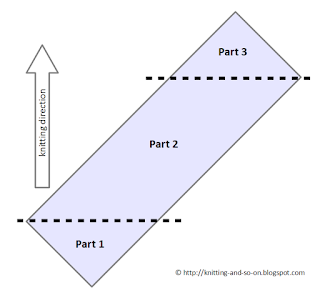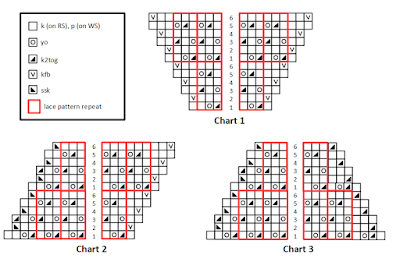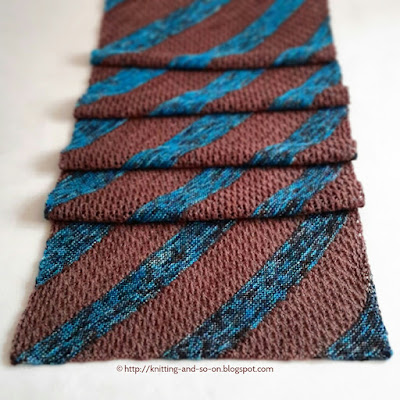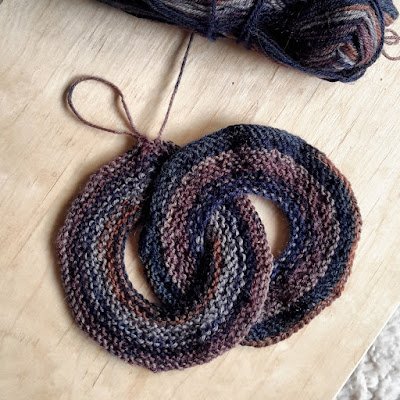Wide stripes of garter stitch show off the beautiful features of the hand-painted yarn while a lace pattern makes the most of the (semi-)solid yarn.
It's called Vermicelli because the lace pattern looks a bit like little caterpillars and because the brown color reminded me of one of my favorite autumn desserts - Vermicelles.

This work by Knitting and so on is licensed under a Creative Commons Attribution-NonCommercial-ShareAlike 4.0 International License.

Tweet
Materials
- 3.5 mm needles
- 100 grams of yarn in color 1 (C1), here I used some beautiful hand-dyed yarn (by Wolleverliebt that I bought at Wollefestival).
- 150 grams of yarn in color 2 (C2), here I used some semi-solid Wollmeise Pure Merino that I bought some years ago
- tapestry needle to weave in ends
Construction
 The vermicelli wrap forms a rectangle but is knitted diagonally. You start with only a few stitches and increase on both sides (part 1). During the next part the stitch count stays the same but you increase on one side and decrease on the other (part 2). When the scarf is long enough you decrease on both sides and finish (part 3).
The vermicelli wrap forms a rectangle but is knitted diagonally. You start with only a few stitches and increase on both sides (part 1). During the next part the stitch count stays the same but you increase on one side and decrease on the other (part 2). When the scarf is long enough you decrease on both sides and finish (part 3).Techniques
- If you want to avoid cutting your yarn every time you change color, you'd want to carry the yarn up the side of your work - there are several ways to do this - e.g. as shown in this YouTube video by New Stitch a Day. or as shown in this YouTube video by The Knitting Vortex.
Instructions
Part 1
In color 1
CO4
R1: k all stitches
R2: kfb, k to last stitch, kfb
-> repeat 12 more times (i.e. you have knitted a total of 26 rows with C1 and there are 30 sts on your needles)
Color 2
Setup Row 1: k all stitches
Setup Row 2: kfb, p to last stitch, kfb
-> then knit chart 1 for the next 34 rows (i.e. you have knitted a total of 36 rows with C2 and now there are 66 sts on your needles)
Here's the pattern from chart 1 spelled out:
R1: k1, * k2tog, yo, k1 repeat from * until there is only one stitch left, k1
R2 and all even numbered rows: kfb, p to last stitch, kfb
R3: k2, * yo, k1, k2tog repeat from * until there are only two stitches left, k2
R5: k3, * k1, k2tog, yo repeat from * until there are three stitches left, k3
The pattern is a repeat of six rows - the charts show 12 rows of it to illustrate how to handle the increases or decreases.
Color 1
R1: k all stitches
R2: kfb, k to last stitch, kfb
-> repeat 11 more times (i.e. you have knitted 24 rows with C1 and there are now 90 stitches on your needles)
Color 2
Setup Row 1: k all stitches
Setup Row 2: kfb, p to last stitch, kfb
-> then knit chart 1 for the next 34 rows (i.e. you have knitted a total of 36 rows with C2 and now there are 126 sts on your needles)
Color 1
R1: k all stitches
R2: kfb, k to last stitch, kfb
-> repeat 11 more times (i.e. you have knitted 24 rows with C1 and there are now 150 stitches on your needles)
If you want your wrap to be wider you can repeat the last two stripes again.
Part 2
First stripe of part 2 with color 2
Setup Row 1: k all stitches
Setup Row 2: kfb, p to last stitch, kfb (-> now there are 152 stitches)
-> then knit chart 2 for the next 34 rows (i.e. you have knitted a total of 36 rows with C2, since there is always an decrease at the beginning of an even-numbered row and an increase at the end of it, the stitch count will from now on stay the same during part 2)
Here's the pattern of chart 2 spelled out
R1: k1, * k2tog, yo, k1 repeat from * until there is only one stitch left, k1
R2 and all even numbered rows: ssk, p to last stitch, kfb
R3: k2, * yo, k1, k2tog repeat from * to end
R5: k3, * k1, k2tog, yo repeat from * until there are two stitches left, k2
Color 1
R1: k all stitches
R2: ssk, k to last, kfb
-> repeat 11 more times (i.e. you have knitted 24 rows with C1)
Color 2
Setup Row 2: ssk, p to last stitch, kfb
-> then knit chart 2 for the next 34 rows (i.e. you have knitted a total of 36 rows with C2)
Repeat the last two stripes of color 1 and 2 until your wrap has the desired length.
Part 3
Color 1
R1: k all stitches
R2: ssk, k to last, k2tog
-> repeat 11 more times (i.e. you have knitted 24 rows with C1 - there are now 128 sts on your needles, i.e. if you subtract 2 edge stitches there are 126 stitches - a number that's divisible by 3)
Color 2
Setup Row 2: ssk, p to last stitch, k2tog
-> then knit chart 3 for the next 34 rows (i.e. you have knitted a total of 36 rows with C2, and there are 92 stitches on your needles)
Here's the pattern of chart 3 spelled out:
R1: k1, * k2tog, yo, k1 repeat from * until there is only one stitch left, k1
R2 and all even numbered rows: ssk, p to last stitch, k2tog
R3: k3, * yo, k1, k2tog repeat from * to end
R5: k2, * k1, k2tog, yo repeat from * until there are two stitches left, k2
Repeat these two stripes (color 1 and color 2) once more - now there are only 32 stitches left.
With color 1 repeat the following rows until there are only 4 stitches left
R1: k all stitches
R2: ssk, k to last, k2tog
Then bind off.
Weave in ends and block.












